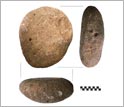News Release 09-049
Wild Grass Became Maize Crop More Than 8,700 Years Ago
Probably domesticated in the Mexican tropical forest

New research says corn was domesticated from teosinte 1,500 years earlier than formerly documented.
March 23, 2009
This material is available primarily for archival purposes. Telephone numbers or other contact information may be out of date; please see current contact information at media contacts.
The earliest physical evidence for domesticated maize, what some cultures call corn, dates to at least 8,700 calendar years ago, and it was probably domesticated by indigenous peoples in the lowland areas of southwestern Mexico, not the highland areas.
This new evidence comes from an international team of researchers, who report the findings in two companion papers in this week's Proceedings of the National Academy of Sciences. They place maize domestication in Mexico about 1,500 years earlier than previously documented there and 1,200 years earlier than the next earliest dated evidence for maize in Panama.
"Our primary goal was to document the early history of maize domestication in the homeland of its wild ancestor," said Anthony Ranere, Department of Anthropology at Temple University, Philadelphia, Pa. He acknowledged the timelines make a good deal of sense because the wild ancestor of maize is native to the regions of southwestern Mexico where the team worked, and these regions had not been previously explored by archaeologists.
Researchers focused on the Xihuatoxtla Shelter in an area of the Balsas Valley that is home to a large, wild grass called Balsas teosinte that molecular biologists recently identified as the ancestor of maize. The shelter contained early maize and squash remains as well as ancient stone tools used to grind and mill the plants.
"We found the remains of maize and squash in many contexts from the earliest occupation levels," said Dolores Piperno, senior scientist and curator of archaeobotany and South American archaeology for the Smithsonian's Museum of Natural History in Washington, D.C. "This indicates these two crops were being routinely consumed nearly 9,000 years ago."
Ranere and Piperno discuss both the archaeological context and botanical evidence for maize and squash domestication in the papers published in the Proceedings of the National Academy of Sciences. Ranere is the first author of the archaeological paper, while Piperno is the first author of the botanical paper. Both papers result from work by the same five investigators, including Irene Holst, Smithsonian Tropical Research Institute, Panama; Jose Iriarte, University of Exeter, U.K.; and Ruth Dickau, Temple University. The research is partially funded by the National Science Foundation.
"Finding early human settlements in this part of Mexico is also very important, as it shows people were becoming well-adapted to tropical forest settings early on," said Piperno. The findings suggest domestication of maize in Mexico's lowland areas as opposed to highland areas as has long been thought.
The search for maize origins in the 1950s through the 1970s focused on arid or semi-arid regions in the Mexican highlands where preservation of dried out plant remains was common. Not surprisingly, the earliest maize remains in the form of maize cobs and kernels came from highland caves and rock shelters.
But search locations shifted when molecular biologists began to study where the ancestor of maize, teosinte, grows today and when researchers began using phytoliths and starch grains to identify maize and other plant species, both domesticated and wild, in the 1990s. Starch grains and phytoliths are microscopic particles that occur in leafs, stems and roots of many plants, and unlike whole seeds and roots are well-preserved in tropical forest environments, such as those in lowland areas of Mexico and Panama.
Even more, phytolith and starch grain evidence allowed researchers to trace the dispersal of maize as a domesticated crop from its origin in or around the Balsas Valley to Panama by 7,600 years ago and shortly thereafter to Colombia and Ecuador, and to Uruguay by 4,600 years ago.
The researchers acknowledge, however, that maize already appears to have been domesticated in the earliest occupation of the Xihuatoxtla Shelter. "We did not find evidence for the earliest stages in the domestication process," said Ranere. "We need to find more ancient deposits in order to document the beginning of the process."
-NSF-
-
Researchers excavated the Xihuatoxtla Shelter in Mexico finding 8,700 year-old maize remains.
Credit and Larger Version -
Ancient stone tools used to grind and mill maize and squash were found in the Xihuatoxtla Shelter.
Credit and Larger Version -
Image of a 7,800 year-old maize starch grain.
Credit and Larger Version
Media Contacts
Bobbie Mixon, NSF, (703) 292-8485, email: bmixon@nsf.gov
Program Contacts
John E. Yellen, NSF, (703) 292-8759, email: jyellen@nsf.gov
Principal Investigators
Anthony J. Ranere, Temple University, 215-204-1423, email: ranere@temple.edu
Dolores R. Piperno, Smithsonian National Museum of Natural History, 202-633-1912, email: pipernod@si.edu
The U.S. National Science Foundation propels the nation forward by advancing fundamental research in all fields of science and engineering. NSF supports research and people by providing facilities, instruments and funding to support their ingenuity and sustain the U.S. as a global leader in research and innovation. With a fiscal year 2023 budget of $9.5 billion, NSF funds reach all 50 states through grants to nearly 2,000 colleges, universities and institutions. Each year, NSF receives more than 40,000 competitive proposals and makes about 11,000 new awards. Those awards include support for cooperative research with industry, Arctic and Antarctic research and operations, and U.S. participation in international scientific efforts.
Connect with us online
NSF website: nsf.gov
NSF News: nsf.gov/news
For News Media: nsf.gov/news/newsroom
Statistics: nsf.gov/statistics/
Awards database: nsf.gov/awardsearch/
Follow us on social
Twitter: twitter.com/NSF
Facebook: facebook.com/US.NSF
Instagram: instagram.com/nsfgov





